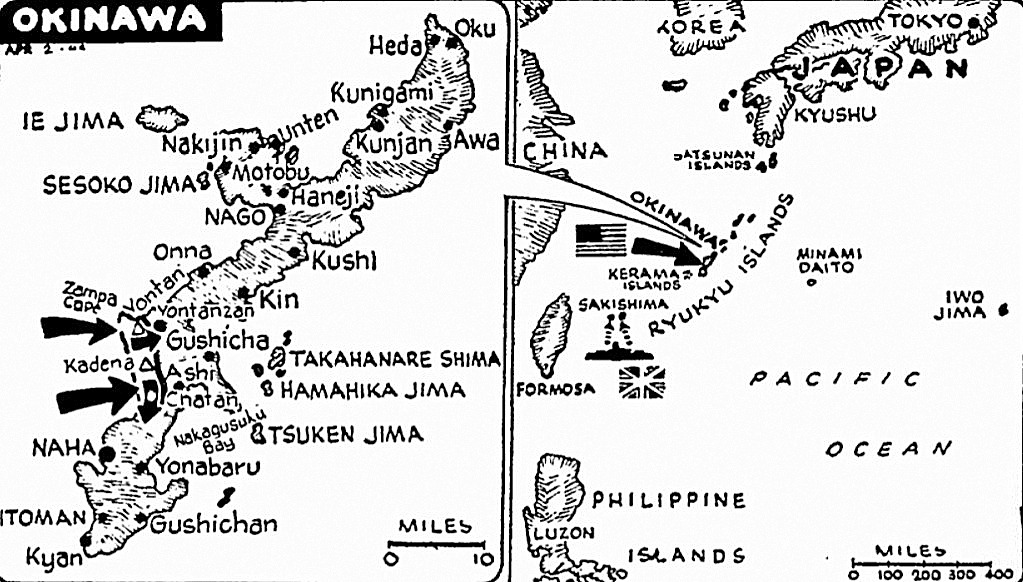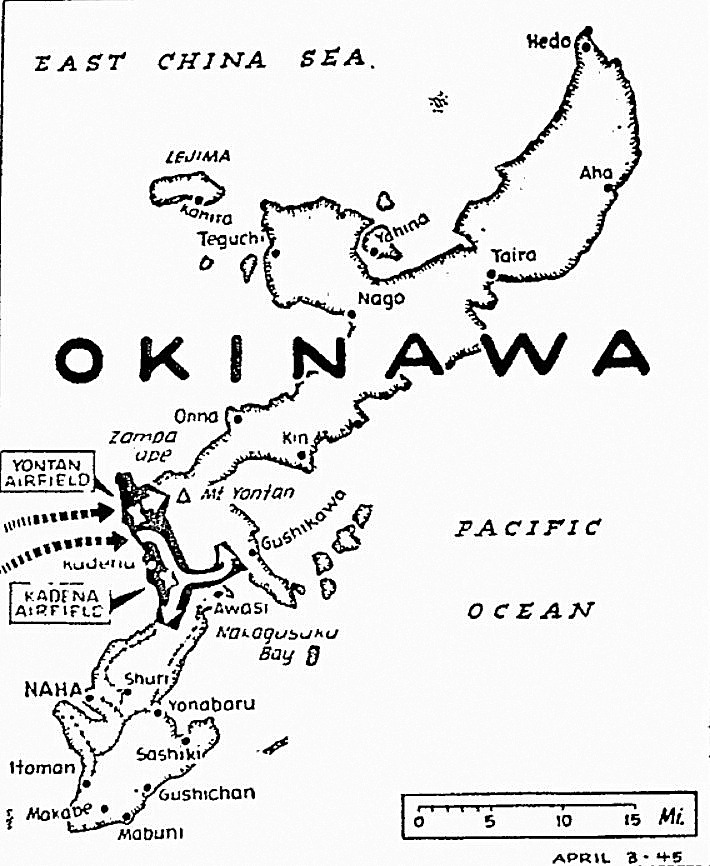The Pittsburgh Press (April 2, 1945)
Jap resistance flares on southern flank as invaders near capital

Ashore on a key Jap base, U.S. soldiers and Marines were closing on Naha, the capital of Okinawa Island. U.S. forces seized a beachhead 8¾ miles long on the west coast of the island and drove halfway to the eastern shore. The Americans landed between Zampa Cape and Chatan and drove through the latter town toward Naha. British warships supported the American operation by bombing the Sakishima Islands to the southwest.
GUAM (UP) – U.S. invasion troops smashed forward more than halfway across Okinawa today in a swift advance against scattered Jap sniper and pillbox resistance.
Front dispatches said an announcement that Okinawa had been split in two was expected hourly.
Hard fighting flared on the southern flank of the U.S. Army-Marine front where tank-led infantrymen were driving toward Naha, the island’s burning capital, less than seven miles distant.
Tokyo radio reported without Allied confirmation that Americans completed a new landing today on Kume, 52 miles west of Okinawa and 340 miles northwest of Formosa.
Tens of thousands of troops of the new U.S. Tenth Army smashed ashore along a wide beachhead. Two airfields and more than a dozen villages were captured. Dispatches indicated U.S. planes soon would be using at least one of the two captured airdromes.
United Press writer E. G. Valens, accompanying forward elements of two Army units driving across Okinawa from the captured Kadena Airfield, said resistance continued to be comparatively light. This column was heading downhill toward Noza and the Nagusuku Bay naval anchorage on the east side of the island.
The hardest fighting raged in the “badlands” north of Naha, the prime objective of this invasion only 362 miles south of Japan.
Roads heavily mined
There, the troops under Lt. Gen. Simon Bolivar Buckner collided with Jap-prepared positions and machine-gun nests. Roads were heavily mined. But when the mines were neutralized, soldiers moved in on bulldozers to widen the roads.
Carrier planes from the invasion armada lying offshore pinpointed enemy targets ahead of advancing troops.
Mr. Valens said one dauntless dive bomber made an emergency landing on Kadena airstrip. It was the first large American plane to land there.
Wrecked planes everywhere
At Kadena, the attackers found gun emplacements were little more than wooden pigsties. The wreckage of Jap planes lay scattered across the captured airfields, indicating the effectiveness of the pre-invasion bombardment and carrier strikes.
Norman Paige, Blue Network correspondent, reported from Okinawa that Jap civilians here begun surrendering “in droves.” “They seemed glad to give themselves up,” Mr. Paige said.
Mr. Paige said the “general impression” on Okinawa was that the main Jap garrison had moved to Formosa, was hiding in the hills or underground, or had been fooled into believing the landing would occur at the southern tip of Okinawa instead of the south-central west coast.
Capital’s towers in sight
Radio towers of Naha, a city of 165,000, were clearly visible to advancing U.S. troops.
The Yanks were already days ahead of schedule on their greatest invasion of the Pacific war.
Reinforcements of men, tanks, guns and supplies were flowing across the beaches in a steady stream.
Warships ranging from new 45,000-ton battleships to rocket-firing gunboats poured a steady drumfire of shells into enemy positions ahead of the ground forces. Some 1,500 carrier planes also shuttled back and forth over the island.
A Jap communiqué conceded that the Americans were continuing to reinforce the beachhead, but claimed that Jap forces had intercepted the invaders in “furious fighting.”
Melbourne radio reported that Australian monitors heard a Jap broadcast asserting that Allied invasion forces also landed on Kume Island, 52 miles west of Naha. Kume is the westernmost of the Ryukyu Island chain.
The enemy communiqué also asserted that 41 more ships in the invasion armada had been sunk or damaged.
Close on Japan
The landing on Okinawa brought U.S. forces nearly twice as close to Japan proper as they are on Iwo, 750 miles south of Tokyo. The northern tip of 65-mile-long Okinawa lies only 330 miles southwest of Kyushu, southernmost of the Jap home islands.
Capture of the island would give the Americans strategic air, land and sea bases from which to mount an eventual invasion of Japan proper or the China coast, only 400 miles to the west.
Adm. Chester W. Nimitz, commander of the Pacific feet, hailed the invasion as assuring “our final decisive victory.”
Severing life line
Adm. Richmond Kelly Turner, commander of the invasion fleet, said capture of Okinawa would sever Japan’s lifeline to her southern empire and make it impossible for her fleet to operate or base in Southern Japan. Traffic on the Yangtze River, lifeline of the Jap Army in China, also would be shut off. he said.
The main landing on Okinawa was preceded by landings beginning last Monday on the Kerama Islands 10 to 20 miles west of Okinawa.
Maj. Gen. Andrew D. Bruce’s 77th Infantry Division quickly seized all eight islands in the group and set up heavy artillery to support the Okinawa invasion. A seaplane and harbor base was established at one island.
10-day bombardment
An unprecedented 10-day air and sea bombardment, during which warships alone hurtled 5,000 tons of steel and explosives into the Jap defenses, paved the way for the landing on Okinawa by the Tenth Army under Lt. Gen. Simon Bolivar Buckner Jr., former commander in Alaska.
Front dispatches said Maj. Gen. John R. Hodge’s XXIV Army Corps, veterans of Leyte, landed at the southern end of the beachhead against little more than occasional sniper fire.
Meet light opposition
The first regiment ashore swept a mile south across rice paddies and grain fields to the burning farm village of Kue, then swarmed down onto the flat, rolling shoreline leading south to Naha.
Command post radios reported battalion troops along the shore before dusk last night had driven through Chatan, eight miles north of Naha, against light opposition, including some mortar and rifle fire.
Other Army troops, spearheaded by amphibious tanks, struck inland and seized the Kadena Airfield, then fanned out against still bafflingly-light resistance. The Japs blew up few bridges, but others were captured intact by the Army troops.
Capture height
Another Army column captured a strategic height at Nozato, northernmost point of a hill mass dominating the southern sector of the assault area.
Late reports from the Army front said heavy American equipment was rolling inland over narrow roads six to eight feet wide and through sandy fields. Many troops walked boldly upright through rolling fields of sugarcane, sweet potatoes and grain.
Even lighter resistance, if possible, was met by Maj. Gen. Roy S. Geiger’s III Marine Amphibious Corps, conquerors of Guam, at the northern end of the beachhead.
Not a single Marine was killed or wounded in the first half hour of the invasion and, 8½ hours later, most Marines were yet to see a Jap soldier. U.S. casualties were described as “incredibly light.”
Take airfield quickly
The Marines went ashore at and south of Zampa Cape, some 16 miles north of Naha and westernmost point of the island, and in the first hour captured Yontan Airfield.
Gen. Geiger, veteran of many other Pacific campaigns, expressed amazement at the lack of resistance met by his forces.
“I’m damned if I’ve ever been on a battlefield hike this,” he said. “They’re sunk now.”
Big Jap force on island
The Japs were known to have 60,000 to 80,000 troops on Okinawa and their failure to oppose the landing was even more surprising in view of the fight to the death put up by the enemy garrison at Iwo.
Okinawa is also the most heavily populated Jap island yet invaded by the Americans. Its 435,000 inhabitants comprise nearly half the entire population of the Ryukyu Island chain, stretching from Japan to Formosa.
At the end of the first day, Gen. Buckner said he was “elated” with the progress of the campaign.
“We are locking down the Mikado’s throat.” he said.
Adm. Turner, on his flagship, was more conservative. He was “satisfied.”
Eleven to 13 Jap planes attempted to attack the invasion armada during the landing operations, but all were destroyed.
A British task force supported the invasion with a carrier-based air assault on Ishigaki and Miyako Islands in the Sakishima group southwest of Okinawa Saturday and Sunday. Of 20 Jap planes which landed in the Sakishimas during the attacks, 14 were destroyed and six damaged by the British aircraft.

